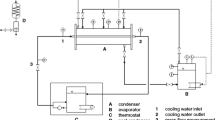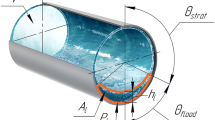Abstract
The heat transfer coefficient and pressure drop are investigated for propane. Two different mild steel plain tubes and saturation pressures are considered for varying mass flux and vapour quality. The pressure drop is compared to the Friedel-Correlation with two different approaches to determine the friction factor. The first is calculation as proposed by Friedel and the second is through single phase pressure drop investigations. For lower vapour qualities the experimental results are in better agreement with the approach of the calculated friction factor. For higher vapour qualities the experimental friction factor is more precise. The pressure drop increases for a decreasing tube diameter and saturation pressure. The circumferential temperature profile and heat transfer coefficients are shown for a constant vapour quality at varying mass fluxes. The subcooling is highest for the bottom of the tube and lowest for the top. The average subcooling as well as the circumferential deviation decreases for rising mass fluxes. The averaged heat transfer coefficients are compared to the model proposed by Thome and Cavallini. The experimental results are in good agreement with both correlations, however the trend is better described with the correlation from Thome. The experimental heat transfer coefficients are under predicted by Thome and over predicted by Cavallini.














Similar content being viewed by others
Abbreviations
- cp :
-
Specific isobaric heat capacity
- d:
-
Diameter (mm)
- G:
-
Mass flux (kg/m2s)
- h:
-
Specific enthalpy (kJ/kg)
- K:
-
Absolute sand roughness (mm)
- L:
-
Tube length (m)
- ṁ:
-
Mass flow (kg/s)
- n:
-
Number of thermocouples in one measurement section [−]
- Re:
-
Reynolds number (−)
- T:
-
Temperature (°C)
- q̇:
-
Heat flux (W/m2)
- Q̇:
-
Heat flow (W)
- w:
-
Velocity (m/s)
- x:
-
Vapour quality (−)
- z:
-
Position in axial direction (m)
- α:
-
Heat transfer coefficient (W/m2K)
- δ:
-
Derivate (−)
- Δ:
-
Difference (−)
- λ:
-
Thermal conductivity (W/mK)
- ξ:
-
Friction factor (−)
- ρ:
-
Density (kg/m3)
- φ:
-
Angle (°)
- an:
-
Angular
- cal:
-
Calculated
- ev:
-
Evaporation
- exp:
-
Experimental
- i:
-
Counting parameter in axial direction of the test tube
- in:
-
Internal
- j:
-
Counting parameter in radial direction of the test tube
- l:
-
Liquid
- oil:
-
Oil
- p:
-
Propane
- v:
-
Vapour
- w:
-
Wall
References
Cavallini A, Censi G, Del Col D, Doretti L, Longo GA, Rossetto L (2001) Experimental investigation on condensation heat transfer and pressure drop of new HFC refrigerants (R134a, R125, R32, R410A, R236ea). Int J Refrig 24:73–87
Garimella S, Macdonald M (2016) Hydrocarbon condensation in horizontal tubes. Part I – measurements. Int J Heat Mass Transf 93:75–85
Cavallini A, Zecchin R (1974) A dimensionless correlation for heat transfer in forced convection condensation. 6th Int. Heat Transfer Conference, Tokyo
Cavallini A, Censi G, Del Col D, Doretti L, Longo GA, Rossetto L (2002) Condensation of halogenated refrigerants inside smooth tubes. HVAC R Res 8:429–451
Cavallini A, Del Col D, Doretti L, Matkovic M, Rossetto L, Zilio C, Censi G (2006) Condensation in horizontal smooth tubes: a new heat transfer model for heat exchanger design. Heat Transfer Eng 27:31–38
Thome JR, Cavallini A, El-Hajal J (2003) Condensation in horizontal tubes, part 2: new heat transfer model based on flow regimes. Int J Heat Mass Transf 46:3365–3387
Thome JR, Cavallini A, El-Hajal J (2003) Condensation in horizontal tubes, part 1: two phase flow pattern map. Int J Heat Mass Transf 46:3349–3363
Steiner D (2006) Strömungssieden gesättigter Flüssigkeit; Abschnitt Hbb; VDI-Wärmeatlas, 10th edn. Springer-Verlag, Berlin
Cavallini A, Censi G, Del Col D, Doretti A, Longo GA, Rossetto A (1999) Condensation heat transfer with refrigerants. Proc. 1st Int. Symposium of the Two-Phase Flow Modelling and Experimentation, Pisa
Wongwises S, Dakilic AS (2009) Intensive literature review of condensation inside smooth and enhanced tubes. Int J Heat Mass Transf 52:3409–3426
Konakov PK (1946) A new equation for the friction coefficient for smooth tubes. Report of the Academic Society for Science of the UdSSR 51:503–506
Gnielinski V (2006) Druckverlust bei der Strömung durch Rohre; Abschnitt Lb; VDI-Wärmeatlas, 10th edn. Springer-Verlag, Berlin
Colebrook CF (1939) Turbulent flow in pipes, with particular reference to the transition region between the smooth and rough pipe laws. J Inst Civ Eng 11:133–156
Friedel L (1979) Improved friction pressure drop correlations for horizontal and vertical two phase flow. European Two Phase Flow Group Meeting, Ispra
Author information
Authors and Affiliations
Corresponding author
Rights and permissions
About this article
Cite this article
Fries, S., Skusa, S. & Luke, A. Heat transfer and pressure drop of condensation of hydrocarbons in tubes. Heat Mass Transfer 55, 33–40 (2019). https://doi.org/10.1007/s00231-018-2318-2
Received:
Accepted:
Published:
Issue Date:
DOI: https://doi.org/10.1007/s00231-018-2318-2




